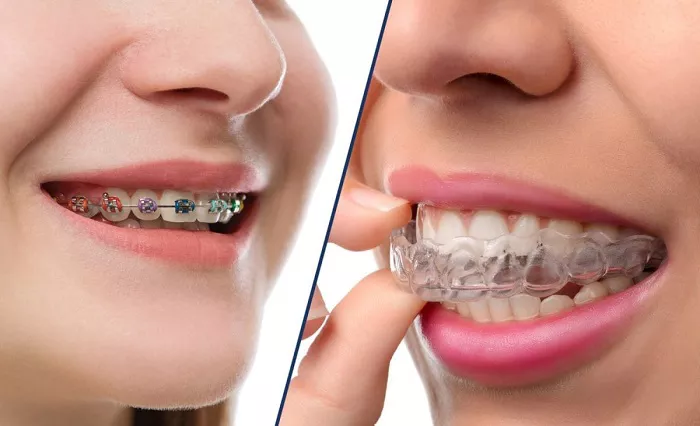When it comes to straightening teeth, patients often wonder: Is Invisalign the same as traditional braces? While both options aim to achieve a straighter smile, they differ significantly in terms of appearance, functionality, and treatment experience. In this article, we’ll explore the key differences and similarities between Invisalign and traditional braces, helping you make an informed decision about which option is best for you.
What Are Traditional Braces?
Traditional braces consist of metal brackets bonded to the teeth and connected by wires and elastic bands. Over time, the orthodontist adjusts the tension on the wires to gradually move the teeth into the desired position. Braces are highly effective for treating a wide range of orthodontic issues, including severe misalignment and bite problems.
What Is Invisalign?
Invisalign is a popular brand of clear aligners that uses a series of custom-made, transparent trays to straighten teeth.
These aligners are removable, nearly invisible, and designed to fit snugly over the teeth. Invisalign is often preferred by adults and teens who want a more discreet and comfortable orthodontic solution.
Key Differences Between Invisalign and Traditional Braces
While both Invisalign and traditional braces serve the same purpose, they differ in several important ways:
Appearance
Traditional Braces: Made of metal brackets and wires, braces are highly visible and can be a concern for those who are self-conscious about their appearance.
Invisalign: The clear aligners are virtually invisible, making them an attractive option for those who want to straighten their teeth discreetly.
Comfort
Traditional Braces: Metal brackets and wires can cause irritation to the gums and cheeks, especially during the initial adjustment period.
Invisalign: The smooth plastic aligners are more comfortable to wear and less likely to cause irritation.
Removability
Traditional Braces: Braces are fixed to the teeth and cannot be removed by the patient.
Invisalign: Aligners are removable, allowing patients to eat, drink, and clean their teeth without restrictions.
Treatment Duration
Traditional Braces: Treatment typically takes 18 to 36 months, depending on the complexity of the case.
Invisalign: Treatment often takes 6 to 18 months, making it a faster option for many patients.
Maintenance and Hygiene
Traditional Braces: Cleaning around brackets and wires can be challenging, increasing the risk of plaque buildup and cavities.
Invisalign: Since aligners are removable, patients can brush and floss their teeth as usual, making oral hygiene easier to maintain.
Dietary Restrictions
Traditional Braces: Patients must avoid hard, sticky, and chewy foods that can damage the brackets and wires.
Invisalign: There are no dietary restrictions since aligners are removed during meals.
Key Similarities Between Invisalign and Traditional Braces
Despite their differences, Invisalign and traditional braces share some common features:
Orthodontic Goals
Both treatments aim to straighten teeth, correct bite issues, and improve overall oral health.
Professional Supervision
Both options require regular visits to an orthodontist or dentist to monitor progress and make adjustments.
Customization
Both Invisalign and traditional braces are customized to fit the patient’s teeth and address their specific orthodontic needs.
Retention Phase
After completing treatment, patients must wear retainers to prevent their teeth from shifting back to their original position.
Which Orthodontic Issues Can Invisalign and Braces Treat?
Both Invisalign and traditional braces are effective for treating a wide range of orthodontic issues, but they each have their strengths and limitations:
Crowding
Both treatments can effectively address crowded teeth, though severe cases may require traditional braces for more precise control.
Spacing
Both options can close gaps between teeth, but Invisalign is often preferred for mild to moderate spacing issues.
Overbite, Underbite, and Crossbite
Traditional braces are generally more effective for correcting significant bite issues, while Invisalign may be suitable for mild to moderate cases.
Rotated Teeth
Traditional braces are better suited for correcting severely rotated teeth, as they provide more precise control over tooth movement.
How to Choose Between Invisalign and Traditional Braces
The choice between Invisalign and traditional braces depends on several factors, including:
Severity of Your Orthodontic Issues
If you have severe misalignment or bite issues, traditional braces may be the better option. For mild to moderate cases, Invisalign is often sufficient.
Lifestyle and Preferences
Consider your lifestyle and how each treatment will fit into it. If you value discretion and convenience, Invisalign may be the better choice. If you prefer a more hands-off approach, traditional braces might suit you better.
Budget
Invisalign is typically more expensive than traditional braces, so your budget may influence your decision.
Compliance
If you’re confident in your ability to wear aligners as directed, Invisalign can be a great option. If you’re concerned about compliance, traditional braces may be more reliable.
Conclusion
Invisalign and traditional braces are both effective orthodontic treatments, but they cater to different needs and preferences. Invisalign offers a discreet, comfortable, and convenient option for those with mild to moderate orthodontic issues, while traditional braces provide a reliable solution for more complex cases.To determine which option is best for you, consult with an experienced orthodontist who can evaluate your specific needs and recommend the most appropriate treatment. Whether you choose Invisalign or traditional braces, the end result will be a straighter, healthier smile that you can be proud of.

